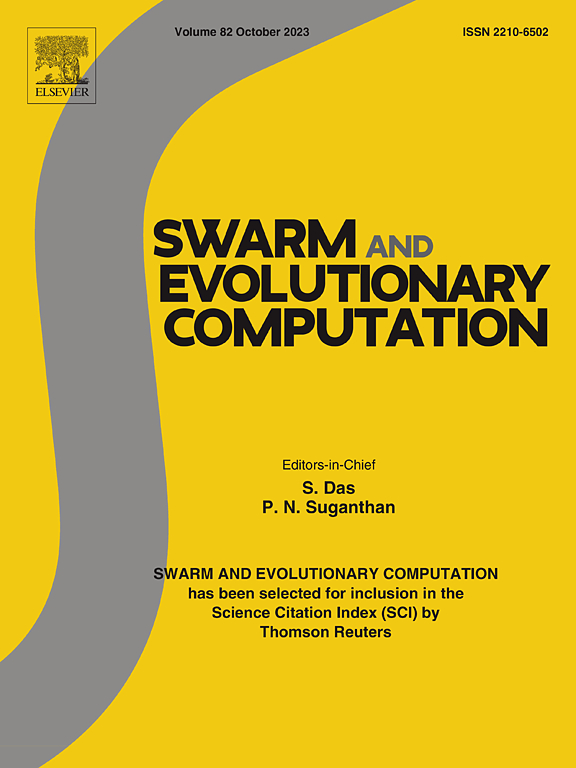Goal-directed multimodal multi-objective evolutionary algorithm converging on population derivation
IF 8.2
1区 计算机科学
Q1 COMPUTER SCIENCE, ARTIFICIAL INTELLIGENCE
引用次数: 0
Abstract
Recently, multimodal multi-objective problems (MMOPs) have become a popular research field in multi-objective optimization problems. The key to solving MMOPs lies in finding multiple equivalent Pareto sets (PSs) corresponding to the Pareto front (PF). Therefore, while balancing the convergence and diversity of the algorithm, it is crucial to enhance its search ability in the decision space. Current research mainly focuses on identifying solutions with exploratory potential, retaining their advantages during evolution, thereby increasing the chances of finding more equivalent PSs. However, these potential solutions and the resulting high-quality solutions are often scarce and require multiple iterations to effectively explore their space. Based on this, this paper proposes a goal-directed multimodal multi-objective evolutionary algorithm converging on population derivation, which includes three stages: population derivation, diversity maintenance, and convergence. In the population derivation stage, the algorithm identifies individuals with exploratory potential and derives more individuals in their subspaces to facilitate more efficient exploration of these subspaces. The diversity maintenance stage balances the population's distribution in both the decision and objective spaces, while the convergence stage accelerates the population's approach to the true PF. These three stages work synergistically under their respective objectives to optimize the distribution of solution sets in both the objective and decision spaces and to obtain the complete set of equivalent Pareto solutions. Experimental results show that this algorithm outperforms several mainstream algorithms on multiple MMOP test sets.
近来,多模态多目标问题(MMOPs)已成为多目标优化问题中的一个热门研究领域。解决多模态多目标问题的关键在于找到与帕累托前沿(PF)相对应的多个等效帕累托集(PS)。因此,在平衡算法的收敛性和多样性的同时,提高算法在决策空间的搜索能力至关重要。目前的研究主要集中在识别具有探索潜力的解决方案,在演化过程中保留其优势,从而增加找到更多等效 PS 的机会。然而,这些潜在的解决方案和由此产生的高质量解决方案往往很少,需要多次迭代才能有效探索其空间。基于此,本文提出了一种目标导向的多模式多目标进化算法,该算法收敛于种群衍生,包括三个阶段:种群衍生、多样性维持和收敛。在种群衍生阶段,算法识别出具有探索潜力的个体,并在其子空间中衍生出更多个体,以促进对这些子空间进行更有效的探索。多样性维持阶段平衡种群在决策空间和目标空间中的分布,而收敛阶段则加速种群接近真正的 PF。这三个阶段根据各自的目标协同工作,以优化解集在目标空间和决策空间中的分布,并获得完整的等效帕累托解集。实验结果表明,该算法在多个 MMOP 测试集上的表现优于几种主流算法。
本文章由计算机程序翻译,如有差异,请以英文原文为准。
求助全文
约1分钟内获得全文
求助全文
来源期刊

Swarm and Evolutionary Computation
COMPUTER SCIENCE, ARTIFICIAL INTELLIGENCEC-COMPUTER SCIENCE, THEORY & METHODS
CiteScore
16.00
自引率
12.00%
发文量
169
期刊介绍:
Swarm and Evolutionary Computation is a pioneering peer-reviewed journal focused on the latest research and advancements in nature-inspired intelligent computation using swarm and evolutionary algorithms. It covers theoretical, experimental, and practical aspects of these paradigms and their hybrids, promoting interdisciplinary research. The journal prioritizes the publication of high-quality, original articles that push the boundaries of evolutionary computation and swarm intelligence. Additionally, it welcomes survey papers on current topics and novel applications. Topics of interest include but are not limited to: Genetic Algorithms, and Genetic Programming, Evolution Strategies, and Evolutionary Programming, Differential Evolution, Artificial Immune Systems, Particle Swarms, Ant Colony, Bacterial Foraging, Artificial Bees, Fireflies Algorithm, Harmony Search, Artificial Life, Digital Organisms, Estimation of Distribution Algorithms, Stochastic Diffusion Search, Quantum Computing, Nano Computing, Membrane Computing, Human-centric Computing, Hybridization of Algorithms, Memetic Computing, Autonomic Computing, Self-organizing systems, Combinatorial, Discrete, Binary, Constrained, Multi-objective, Multi-modal, Dynamic, and Large-scale Optimization.
 求助内容:
求助内容: 应助结果提醒方式:
应助结果提醒方式:


